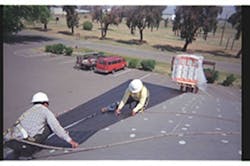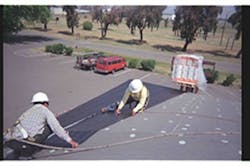When It Counts
“The first job where we used a self-adhesive roofing system was on our ammunition warehouse,” stated Kuo. “With the type of explosive materials that were stored in the warehouse, we could not risk using a kettle or torch for the roofing system installation.”
Kuo turned to Western Roofing Services out of San Francisco, CA. “When specifying the roofing system, I look to Western Roofing Services as the expert in the field. They recommended that we use Polyglass’ ADESO Dual Compound Self-Adhesive Roofing System.”“We have been working at the Travis Air Force Base for at least 25 years,” stated Don Branson, project manger for Western Roofing Services. “We have used hot mop and cold applied built-up systems and torch applied membranes, however with concerns over fire issues and overall levels of security, we felt that the self-adhesive roofing membranes would be a better option.”Estimating the job was John Miller, CEO of Western Roofing Services and a former NRCA president. “We recommend products for specifications that we know will work and that we can stand behind. By working hand in hand with the engineer, architect, or specifier, we all win in the end.”
As a member of Tecta Roofing Services, a national roofing roll-up, Western Roofing Services is known for providing safe, realistic solutions for some of San Francisco’s most challenging projects. “We are always looking for ways to improve safety and security while we are working at the air base or any job. ADESO Dual Compound Self-adhesive membranes from Polyglass have helped us in both of those areas.”
“As the roofing market has evolved, contractors have witnessed the emergence of several types of commercial roofing systems. But through the course of time, bituminous roofing has continued to take the largest strides forward,” stated John DeChandt, western regional manager for Polyglass. “In contrast to other materials and plastics, bituminous roofing offers an unrivalled solution for waterproofing flat roofs. That is why the evolution to bituminous self adhesives is so impressive.”Known for innovative modified bitumen systems, Polyglass has successfully manufactured a wide variety of modified bituminous roofing products for over 35 years. With years of experience in the field of APP and SBS roofing membranes, Polyglass envisioned an opportunity to create a hybrid system based on both traditional technologies. Based on Polyglass’ extensive knowledge of polyester and fiberglass reinforcements and through years of research and development, Polyglass has developed and launched the next generation of roofing called ADESO Dual Compound Self-Adhesive membranes.“One of the main advantages of ADESO, as a roofing contractor, is the lack of torch, mop, or solvent based adhesives due to the inherent self-adhering properties of the membranes,” confirmed Branson. “They stick easily to most surfaces with exceptional adhesion at joints. The end result is no noise, smell, or open flame. This is a key issue when roofing at Travis. We need to be able to get in and out quickly while providing a strong roofing system for the base.”
“Another reason we decided to specify the self adhesives was the lack of smell and the overall cleanliness of the job,” Kuo said. “The roofs are very clean and it is easier for our people to continue their work without the smell or mess.”
“We have re-roofed seven buildings so far using 350 squares of the ADESO Dual Compound Self-Adhesive roofing membranes. It was specified to take advantage of the many benefits associated with self-adhesive membranes,” Branson stated. “We recommended that we use Polyglass’ built-up self-adhesive membranes, ADESO SAV base sheets, and SAP cap sheet.”
Branson’s crew was able to roof top the Polyglass materials with an obvious exclusion; very little equipment. “That is one of the key benefits of self adhesive membranes, “ stated Lucas Hansen, Northern California manufacturer’s representative for Polyglass. “When you are working on a warehouse full of machinery, weapons, and equipment with very little access, you cannot move a lot of equipment up on to the roof. With ADESO, equipment is at a bare minimum.”
“It is a self-contained application,” agreed Natalino Zanchetta, executive vice president for Polyglass. “Contractors do not need mops, torches, or adhesives, the ADESO Self-Adhering system provides extreme ease in application. The self-adhering properties provide the perfect alternative when traditional adhesives or propane torch techniques are not desired. Building owners and property managers love the simplicity of the system.”The seven buildings all had varying decks; wood, metal, and lightweight concrete. For the barrel roofs, which were wood decks, Western started with a fire rated SAV SBS base sheet followed, by an inner ply of ADESO SAV, and topped with SAP white cap sheet. On the metal and lightweight concrete decks, they used the same system with the addition of one inch of polyisocyanurate insulation. Chemcurbs were also used throughout the seven roofs.“The ADESO SAV and SAP Dual Compound Self-adhesive membranes are tough when laid, and shrink free. Due to Polyglass’ U.S. patent pending unique lapping system called SealLap, and U.S. patented granule-free system called FastLap, membranes fit tightly and bond instantaneously to each other,” DeChandtunrivaled continued. “This provides extra security in resisting the weather while providing tough joint connections, whether on a flat or barreled roof.”As the largest contractor of Polyglass ADESO in California, Branson agrees with the benefits and innovations of the product. “Western Roofing Services has been using Polyglass self-adhesives since they were introduced. It is a great system that saves labor and really works. One of the main benefits is not having to use a torch. Fire is simply too much of a risk on the Base. The lap seals with the Adeso system are excellent. With the FastLap and SealLap technology that Polyglass utilizes, we do not have problems with cold joints. All of our seams and joints are tight.”“We like the look of the finished roof,” concluded Kuo. “The system has a premium warranty and very good technical support both from the manufacturer and the contractor. We will be specifying the system for several upcoming projects.”
“It is one of the cleanest roofs you will ever see,” stated Branson. “There is no bleed out and no mess. It is beautiful. We are installing the system on a gas station on the base next week, and in the end, we know it is the safest and most durable choice for all involved.”

